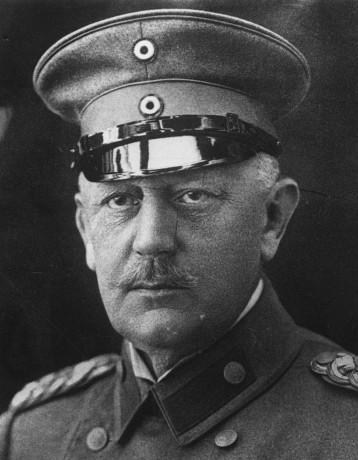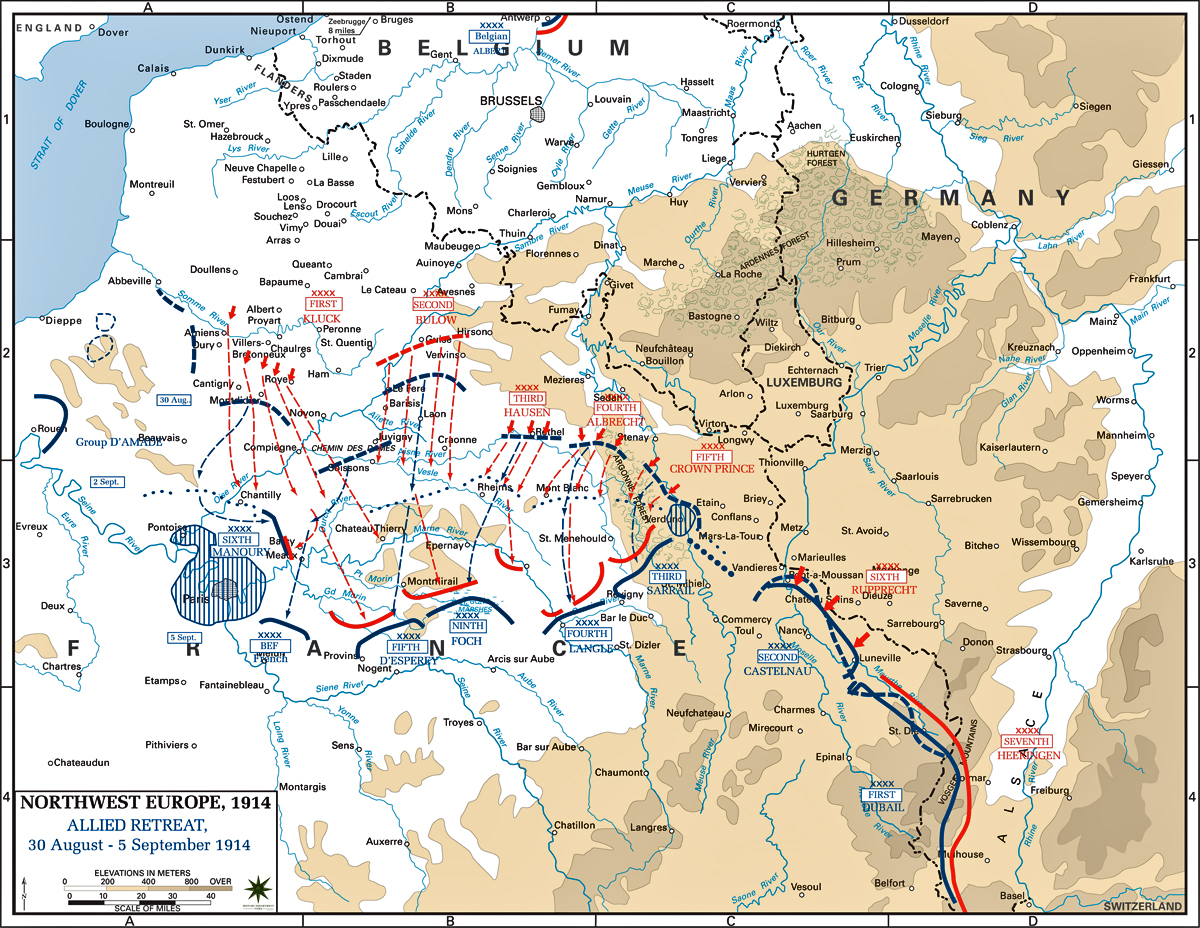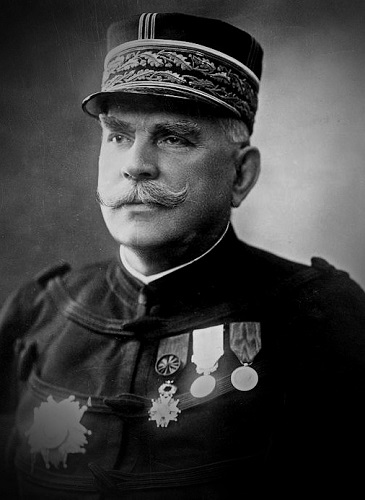● ● ●
For clarity, German formations
are rendered in italics.
Up to 25 August, the German
offensive against France proceeded more or less according to plan.
The three armies of the German right wing had swept over Belgium
into France, pressing back the French and British forces in that
area. Meanwhile the French offensives in Alsace-Lorraine and the
Ardennes had been repulsed with heavy losses. But General von Moltke,
Chief of the OHL (Oberste Heeresleitung or Army High Command)
and de facto commander-in-chief, was far from easy in his mind.
It will be recalled that
Schlieffen’s original Aufmarsch I
West plan demanded the
strongest possible concentration of forces on the right.
Alsace-Lorraine was to be defended by a thin screen of reserve and
Landwehr troops, who would give ground if necessary in the
face of a French offensive. Moltke, however, worried about a French
breakthrough in this sector and took forces from the right wing to
bolster up the left. Then, as the offensive progressed, additional
troops had to be subtracted from the right wing to guard the
advancing armies’ lengthening lines of communications. The
Belgian Army, seven divisions strong, had withdrawn into the
fortified Antwerp position on the Channel coast. From this redoubt
it posed a threat to the German flank, requiring a corps to contain
it. And the series of engagements that the right-wing
armies had already fought cost them many casualties. Thus their
strength steadily diminished as they drew closer and closer to
Paris.

Colonel-General Helmuth Graf von
Moltke, Chief of the Great General Staff 1906-1914 (Bundesarchiv)
Moreover, the German right wing’s
axis of advance had diverged from that set down in Schlieffen’s 1905
plan. “Let the last man on the right brush the Channel with his
sleeve,” he had famously advised—but in the series of battles that
punctuated the Great Retreat, the three armies of the right wing
were drawn farther and farther to the southeast. The map below shows the
German advance between 30 August and and 5 September; note particularly First
Army’s sharp turn to the southeast. Sensing the gap between Fifth Army and the BEF, Kluck sought to exploit it. He was also anxious to
maintain
touch with Second Army on his left. These tactical
considerations, though not without validity, were incompatible with
Schlieffen’s grand design: the envelopment of both Paris and the
left wing of the French Army.
Another worry nagged at Moltke. In
far-off East Prussia the Russian Army had commenced a
major
offensive. Urged on by French pleas for the earliest possible
action, the Russians attacked without waiting for their mobilization
to be completed. Now two Russian field armies were advancing into
the ancient heartland of the Hohenzollern monarchy. The defenders,
embodied in Eighth Army, were outnumbered at least two to
one. Formally the plan was to yield ground in East Prussia if
necessary but patriotic sentiment and considerations of public
morale argued against this. As the Russian offensive developed pressure grew
on Moltke to send reinforcements east, and these could only come
from the western theater. Eventually he succumbed to that pressure,
taking three corps and a cavalry division from the armies of his
right wing and dispatching them to East Prussia—where they arrived
too late to take part in the Battle of Tannenberg.
Moltke also erred in giving in to
the pleas of the commanders of his left-wing armies for permission
to launch a counteroffensive against the French in Alsace-Lorraine.
Having won a great defensive victory they now were eager to go over
to the attack, tempting Moltke with visions of a double envelopment
of the French armies. He therefore sanctioned an attack by Fifth
Army and Sixth Army. But they made little headway
against the French, to whom the advantages of the defensive now
accrued, and suffered heavy casualties (see map below).

Map:
Department of History, USMA West Point
Still, between 25 August and 1
September the advance of the German right wing continued. By the
latter date the French line was bent at a ninety-degree angle with
Verdun as the hinge (see map above). But Moltke continued to fret, observing to his
staff that a truly decisive victory had so far eluded the German
armies. And because OHL was situated in occupied
Luxembourg, far from the fighting front, the exercise of command
from headquarters was increasingly difficult. Bit by bit, Moltke was losing his grip on the battle. And as the fog of
war enveloped him, the Chief of Staff's nerves began to fray.
This command
crisis was
compounded by a lack of intermediate headquarters between OHL and
the field armies. No provision had been made for army group commands
to coordinate, for example, the three armies of the right wing. In
their absence the movements of the individual armies became
disjointed, each commander maneuvering as he thought best. Attempts
to remedy this by putting one army commander in charge of
another, e.g. Bülow (Second Army) over
Kluck (First Army) caused more problems than it solved. This
command defect was to have fateful consequences.

General Joseph Joffre, Commander-in-Chief of the French Army, 1914-16 (Wikimedia
Commons)
But on the
other side it was a different story. Despite the breakdown of his offensive the French
commander-in-chief, General Joffre, preserved an invincible calm.
His fixed intention was to stop the German advance and resume the
offensive at the earliest possible moment, and to that end he took
energetic and decisive action. Troops were transferred from Lorraine to
reinforce the French left wing, while north of Paris a new Sixth
Army was set up using reserve and Territorial divisions. If the
strain of battle affected Joffre he gave no sign of it. He kept to his normal working routine,
including three meals a day—which were taken in silence, all shop
talk being banned. Nor did he tolerate the failures and shortcomings
of subordinates. Generals thought to be lacking in aggression or
grit were ruthlessly sacked. Among them was the unfortunate
commander of the Fifth Army, General Lanrezac. His warnings that the
Germans were attacking in great strength through Belgium had been
ignored and his army, denied reinforcements, had nearly been
encircled and destroyed. Lanrezac's reward for being right when the
Commander-in-Chief was wrong was to be deprived of his command.
The stage was now set for a battle
whose outcome was to decide the whole course of the Great War in the
west. Still advancing, the armies of the German right wing sought to
envelop the French left flank. To that end First Army and
Second Army swerved southeast of Paris—a major departure from
Schlieffen’s plan. He had projected for
First Army a
southwesterly march, enveloping both Paris and the left flank of the
French armies. But now the German right wing was exposing its own
flank to an attack from Paris. The map above
shows the situation on the eve of the First Battle of the Marne;
note especially the axis of advance of First Army, passing
east of Paris—where General Joseph
Gallieni, the recently
appointed Military Governor of Paris, was organizing the
new Sixth Army.
It was a
critical moment, with the odds were closely
balanced. Despite increasing exhaustion and confusion the Germans
still held the initiative, they were still advancing, and one final
effort might give them Paris and victory. But as the French and
British left wing fell back, reinforcements began to reach it and
the front gradually consolidated itself some 25 miles south of the Marne River. The battle that soon
followed was to determine the whole subsequent course of the Great
War.